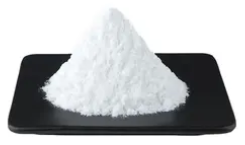Modification of arginine within the sites RGD and GFOGER recognised by the two specific integrins (alpha1beta2 and alpha2beta1) for collagen reduce cell interactions during turnover and for platelet interactions (alpha1beta2)

These changes can ultimately affect repair of, for example, vascular damage and dermal wound healing in diabetes mellitus. Both types of modification are deleterious to the optimal properties of collagen as a supporting framework structure and as a controlling factor in cell matrix interactions. Glycation during ageing and diabetes is therefore responsible for malfunctioning of the diverse collagenous tissues throughout the body.Basal cell carcinoma with collagenous crystalloids.We describe here a unique feature seen in a case of conventional basal cell carcinoma of the skin. In the central portion of the tumor, clusters of collagenous crystalloids composed of radially arranged needle-shaped fibers were found.

Such distinct extracellular matrix deposits may occur in rare cases of pleomorphic adenomas and myoepitheliomas of salivary glands, but to the best of our knowledge, they have never before been described in basal cell carcinoma of Dermatology, Washington University School of Medicine, St. Louis, Missouri. Molecular pathways of cell-mediated degradation of fibrillar collagen.Dentistry Amsterdam (ACTA), University of Amsterdam, Amsterdam, The Netherlands; Vrije Universiteit, Amsterdam, The Netherlands. Electronic address: Dentistry Amsterdam (ACTA), University of Amsterdam, Amsterdam, The Netherlands; Vrije Universiteit, Amsterdam, The Netherlands. Electronic address: Fibrillar collagens are the most abundant components of the extracellular matrix and provide stability to connective tissues, such as bone, cartilage and skin. An imbalance in collagen turnover inevitably affects the function of these tissues.
Therefore, the molecular and cellular mechanisms involved in the synthesis and degradation of collagen have received increasing attention. This short review attempts to summarize our present understanding of how different pathways of collagen degradation are used by different cell types.Collagens and elastin genetic variations and their potential role in aging-related diseases and longevity in humans.for Successful Ageing, St James's Hospital, Dublin 8, Ireland; The Irish Longitudinal Study on Ageing (TILDA), Trinity College Dublin, Dublin, Ireland.. for Successful Ageing, St James's Hospital, Dublin 8, Ireland; The Irish Longitudinal Study on Ageing (TILDA), Trinity College Dublin, Dublin, Ireland.Centre for Health Sciences, St James's Hospital, Dublin 8, Ireland.
Collagens and elastin are 'building blocks' of tissues and extracellular matrix. Mutations in these proteins cause severe congenital syndromes. Adverse genetic variations may accelerate the aging process in adults contributing to premature morbidity, disability and/or mortality. Favorable variants may contribute to longevity and/or healthy aging, but this is much less studied. We reviewed the association between variation in the genes of collagens and elastin and premature aging, accelerated aging, age-related diseases and/or frailty; and the association between genetic variation in those and longevity and/or healthy aging in humans. A systematic search was conducted in MEDLINE and other online databases (OMIM, Genetics Home Reference, Orphanet, ClinVar). Results suggest that genetic variants lead to aging phenotypes of known congenital disease, but also to association with common age-related diseases in adults without known congenital disease.
This may be due to the variable penetrance and expressivity of many variants. Some collagen variants have been associated with longevity or healthy aging. A limitation is that most studies had <1000 participants and their criterion for statistical significance was p < 05. Results highlight the importance of adopting a lifecourse approach to the study of the genomics of aging. ergothioneine mushrooms can help with new methodologies that operationalize [Child abuse and osteogenesis imperfecta. How do we distinguish?].Osteogenesis imperfecta is a hereditary connective tissue disorder.
Cosmetic intermediates are fragile bones with multiple bone fractures and bone deformities. A history of minimal or no trauma and recurrent fractures is a feature of OI, but is also typical of non-accidental injury (NAI). OI and NAI are relevant differential diagnoses when a child presents with unexplained fractures. The differential diagnostic problems are reviewed, all of which are important for the child both in terms of treatment and for prognosis, socially and medicolegally. We conclude that comprehensive clinical evaluation is adequate for differential diagnosis and that both OI and NAI can be diagnosed by positive anamnestic and objective signs. Mild OI IV without other signs than fracture(s) is very rare and the new entity temporary brittle bone disease is hypothetical; the diagnosis of these two clinical pictures is unacceptable in small children. Routine analysis of collagens should not be performed.
Immunolocalisation of collagens in the developing rat molar tooth.
